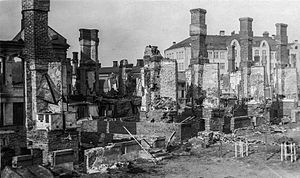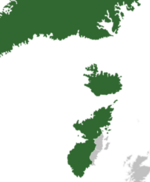Seketese Civil War: Difference between revisions
No edit summary |
|||
| Line 60: | Line 60: | ||
The civil war started with under the backdrop of instability within the Nelbec Empire due to their poor results in [[Nelbec Front|WWI]]. Discontent amoungst Seketese socialists and workers over the course of the war culminated in the Djenibek Uprising by the far-left [[Sosymet Party]] with the support of factions from the [[Seketese Communist Party]]. Sosymet ideolagy called for a ultranationalist socialist state, with non-Seketese ethnic groups like Fjeskand and Trjebians being viewed as "bougouis anti-social class". Opposing the Sosymets were the republican [[Kjeodrate Party|Kjedorates]], the leading party in the [[Seketan under the Nelbec Empire|Imperial Seketese]] [[Hérvynsken|parliament]] who advocated for a {{wp|Liberal democracy|liberal democratic}} republic. Independent of these factions were several regionalist armies and militia's such as [[Wilskland]] and [[Trjebian Militia|Trjebians]]. | The civil war started with under the backdrop of instability within the Nelbec Empire due to their poor results in [[Nelbec Front|WWI]]. Discontent amoungst Seketese socialists and workers over the course of the war culminated in the Djenibek Uprising by the far-left [[Sosymet Party]] with the support of factions from the [[Seketese Communist Party]]. Sosymet ideolagy called for a ultranationalist socialist state, with non-Seketese ethnic groups like Fjeskand and Trjebians being viewed as "bougouis anti-social class". Opposing the Sosymets were the republican [[Kjeodrate Party|Kjedorates]], the leading party in the [[Seketan under the Nelbec Empire|Imperial Seketese]] [[Hérvynsken|parliament]] who advocated for a {{wp|Liberal democracy|liberal democratic}} republic. Independent of these factions were several regionalist armies and militia's such as [[Wilskland]] and [[Trjebian Militia|Trjebians]]. | ||
=Background= | =Background= | ||
==Seketan in the Nelbec Empire== | |||
[[File:NelbecEmpireCropped.PNG|thumb|150px|Nelbec Empire on the eve of WWI, at it's greates extent]] | |||
Since 1765 Seketan had been in a personal union with the Alquiyan crown after the death of King [[Fjedor III]]. In 1884 the two states were united into the [[Nelbec Empire]] with much protest from Seketese aristocrats and merchants, however the much stronger Alquiya was able to easily subdue unrest. For the next 30 years the Nelbec Empire was able to assert itself as a {{wp|great power}} on the international stage, briefly occupying {{wp|Iceland}}, {{wp|Greenland}}, and the Faroe Islands and joining itself into {{wp|Concert of Europe|Europes tangled alliances}}. | |||
Seketan at this time had been reduced to a constiuent state of the Empire still with most of its political and royal insitutions. The [[Hérvynsken]] gained democratic elections after the union for the first time, though this was limited primarily to middle class and wealthy Seketese. The [[Monarchy in Seketan|Crown of the Seketese Kingdom]] remained present in Seketese society, with its royal symbols being often used alongside Alquiyan ones in official capacities. Only the [[Royal Bank of Seketan|royal bank]] and [[Seketese Royal Army]] were dissolved and replaced with Nelbec insitutions. | |||
=Combatants= | =Combatants= | ||
==Kjedorates== | ==Kjedorates== | ||
Revision as of 20:39, 4 November 2022
This article is incomplete because it is pending further input from participants, or it is a work-in-progress by one author. Please comment on this article's talk page to share your input, comments and questions. Note: To contribute to this article, you may need to seek help from the author(s) of this page. |
| Seketese Civil War | ||||||||
|---|---|---|---|---|---|---|---|---|
| Part of the Seketese Revolution and the Revolutions of 1917–1923 | ||||||||
 Civilian buildings in outer Conelibek in 1920 | ||||||||
| ||||||||
| Belligerents | ||||||||
|
|
Regionalists Allies
| ||||||
The Seketese Civil War was a civil conflict fought in Seketan in the aftermath of the Collapse of the Nelbec Empire and the Seketese Revolution. The war was principally fought between the Kjedorate Republic, Sosymet Republic, and Regionalist factions over the direction of an independent Seketan. It resulted in a Kjedorate republican victory, the establishment of a Seketese Republic, and the end of the Seketese Monarchy.
The civil war started with under the backdrop of instability within the Nelbec Empire due to their poor results in WWI. Discontent amoungst Seketese socialists and workers over the course of the war culminated in the Djenibek Uprising by the far-left Sosymet Party with the support of factions from the Seketese Communist Party. Sosymet ideolagy called for a ultranationalist socialist state, with non-Seketese ethnic groups like Fjeskand and Trjebians being viewed as "bougouis anti-social class". Opposing the Sosymets were the republican Kjedorates, the leading party in the Imperial Seketese parliament who advocated for a liberal democratic republic. Independent of these factions were several regionalist armies and militia's such as Wilskland and Trjebians.
Background
Seketan in the Nelbec Empire
Since 1765 Seketan had been in a personal union with the Alquiyan crown after the death of King Fjedor III. In 1884 the two states were united into the Nelbec Empire with much protest from Seketese aristocrats and merchants, however the much stronger Alquiya was able to easily subdue unrest. For the next 30 years the Nelbec Empire was able to assert itself as a great power on the international stage, briefly occupying Iceland, Greenland, and the Faroe Islands and joining itself into Europes tangled alliances.
Seketan at this time had been reduced to a constiuent state of the Empire still with most of its political and royal insitutions. The Hérvynsken gained democratic elections after the union for the first time, though this was limited primarily to middle class and wealthy Seketese. The Crown of the Seketese Kingdom remained present in Seketese society, with its royal symbols being often used alongside Alquiyan ones in official capacities. Only the royal bank and Seketese Royal Army were dissolved and replaced with Nelbec insitutions.
Combatants
Kjedorates
Sosymets
Regionalist forces
Warfare
Start of the war
Djenibek uprising
On October 13, 1919, Sosymet forces numbering around 13,000 covertly gathered in Djenibek began their uprising by seizing government offices, the post office, and key factories. By October 15th they had control over the entire municipality and Sosymet leader Joseph Tinnerdam declared the Sosymet republic, thus kickstarting the Civil War and War of Independence. In response the Imperial Nelbec Army (INA) dispatched the 3rd Division to put down the uprising, however when the unit reached Walybek they mutinied, joining the Sosymet uprising. With control over Djenibek and Walybek secured, the Sosymet army started to expand their control Southward.
Continued Allied Offensive
Facing little resistance from the Nelbec Empire and support from the war-weary population, the Sosymets quickly captured villages while marching towards Fjedor and Sjon. Forces from the INA were stripped from the front line to halt the rebellion, weakening the Nelbec Empires ability to halt the continueing Allied Offensive. On October 30 Allied forces were able to take advantage of the weakened position and encircled INA forces north of Doduc.

